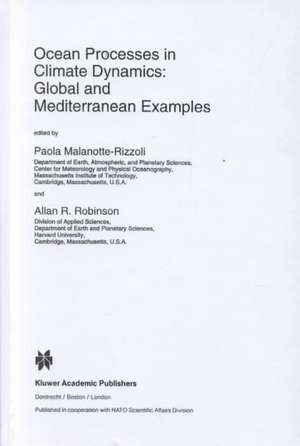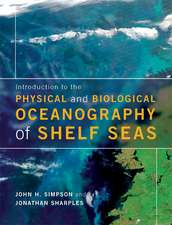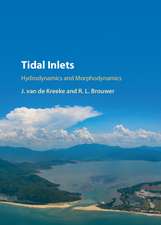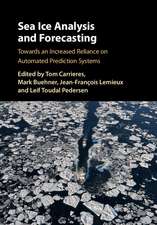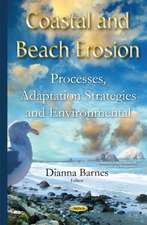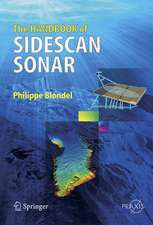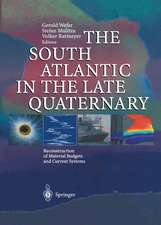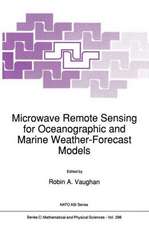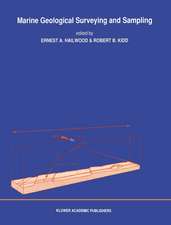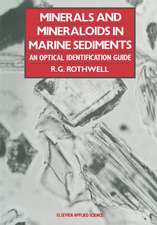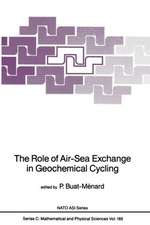Ocean Processes in Climate Dynamics: Global and Mediterranean Examples: Nato Science Series C:, cartea 419
Editat de P.M. Malanotte-Rizzoli, Allan R. Robinsonen Limba Engleză Hardback – 30 noi 1993
| Toate formatele și edițiile | Preț | Express |
|---|---|---|
| Paperback (1) | 1823.70 lei 6-8 săpt. | |
| SPRINGER NETHERLANDS – 5 noi 2012 | 1823.70 lei 6-8 săpt. | |
| Hardback (1) | 1829.86 lei 6-8 săpt. | |
| SPRINGER NETHERLANDS – 30 noi 1993 | 1829.86 lei 6-8 săpt. |
Din seria Nato Science Series C:
- 24%
 Preț: 797.69 lei
Preț: 797.69 lei - 18%
 Preț: 957.62 lei
Preț: 957.62 lei - 18%
 Preț: 957.13 lei
Preț: 957.13 lei - 18%
 Preț: 1227.52 lei
Preț: 1227.52 lei -
 Preț: 396.40 lei
Preț: 396.40 lei -
 Preț: 403.75 lei
Preț: 403.75 lei - 18%
 Preț: 1239.37 lei
Preț: 1239.37 lei - 18%
 Preț: 1236.51 lei
Preț: 1236.51 lei - 18%
 Preț: 1231.78 lei
Preț: 1231.78 lei - 18%
 Preț: 1229.10 lei
Preț: 1229.10 lei - 18%
 Preț: 1835.21 lei
Preț: 1835.21 lei - 24%
 Preț: 1076.39 lei
Preț: 1076.39 lei -
 Preț: 390.46 lei
Preț: 390.46 lei -
 Preț: 369.63 lei
Preț: 369.63 lei - 18%
 Preț: 1232.41 lei
Preț: 1232.41 lei -
 Preț: 394.51 lei
Preț: 394.51 lei - 18%
 Preț: 1226.24 lei
Preț: 1226.24 lei - 18%
 Preț: 1845.80 lei
Preț: 1845.80 lei -
 Preț: 399.88 lei
Preț: 399.88 lei -
 Preț: 384.28 lei
Preț: 384.28 lei -
 Preț: 390.88 lei
Preț: 390.88 lei -
 Preț: 381.19 lei
Preț: 381.19 lei - 18%
 Preț: 1848.64 lei
Preț: 1848.64 lei - 18%
 Preț: 951.14 lei
Preț: 951.14 lei - 18%
 Preț: 1230.35 lei
Preț: 1230.35 lei - 18%
 Preț: 1236.51 lei
Preț: 1236.51 lei -
 Preț: 401.03 lei
Preț: 401.03 lei -
 Preț: 406.25 lei
Preț: 406.25 lei - 18%
 Preț: 1230.84 lei
Preț: 1230.84 lei -
 Preț: 418.34 lei
Preț: 418.34 lei - 18%
 Preț: 1223.74 lei
Preț: 1223.74 lei
Preț: 1829.86 lei
Preț vechi: 2231.53 lei
-18% Nou
Puncte Express: 2745
Preț estimativ în valută:
350.19€ • 364.25$ • 289.10£
350.19€ • 364.25$ • 289.10£
Carte tipărită la comandă
Livrare economică 14-28 aprilie
Preluare comenzi: 021 569.72.76
Specificații
ISBN-13: 9780792326243
ISBN-10: 0792326245
Pagini: 437
Ilustrații: XXII, 437 p.
Dimensiuni: 155 x 235 x 25 mm
Greutate: 0.82 kg
Ediția:1994
Editura: SPRINGER NETHERLANDS
Colecția Springer
Seria Nato Science Series C:
Locul publicării:Dordrecht, Netherlands
ISBN-10: 0792326245
Pagini: 437
Ilustrații: XXII, 437 p.
Dimensiuni: 155 x 235 x 25 mm
Greutate: 0.82 kg
Ediția:1994
Editura: SPRINGER NETHERLANDS
Colecția Springer
Seria Nato Science Series C:
Locul publicării:Dordrecht, Netherlands
Public țintă
ResearchCuprins
Air-Sea Exchanges and Meridional Fluxe.- 1. Air-sea exchanges.- 2. Meridional heat transport.- 3. Conclusion.- Lagrangian and Eulerian Measurements of Ocean Transport Processe.- 1. Introduction.- 2. Eulerian and Lagrangian frameworks.- 3. Transport measures from current followers.- 4. Ocean measurements of lateral transport.- 5. Diapycnal fluxes.- Dispersion and Mixing in the Ocea.- 1. Introduction.- 2. Inference.- 3. Direct measurement.- 4. Indirect measurements.- 5. Processes.- 6. Conclusions.- 7. Discussion.- Ocean Models in Climate Problem.- 1. Introduction.- 2. Feedbacks affecting the thermohaline circulation.- 3. Large-scale air-sea heat exchanges.- 4. Interaction of the hydrological cycle with the thermohaline circulation.- 5. Numerical models of the thermohaline circulation.- 6. Summary and outlook: towards coupled process models.- Sensitivity Studies on the Role of the Ocean in Climate Chang.- 1. Introduction — CME results on thermohaline overturning.- 2. The surface heat and fresh water flux parameterizations.- 3. A basic experiment.- 4. Sensitivity experiments.- 5. Multiple stable states.- 6. Open boundary conditions.- 7. Discussion.- Modeling the Wind and Thermohaline Circulation in the North Atlantic Ocea.- 1. Introduction — the Community Modeling Effort.- 2. Improving surface boundary conditions.- 3. Open boundary conditions for the CME model.- 4. Internal parameterizations for the CME model.- 5. Discussion.- Studying Thermohaline Circulation in the Ocean by Means of Transient Tracer Dat.- 1. Introduction.- 2. Tracer features and geochemistry.- 3. Information from oceanic tracer distribution.- 4. Tracer evaluation by means of ocean circulation models.- 5. Conclusions.- Laboratory and Numerical Experiments in Oceanic Convectio.- 1. Introduction.- 2. Theinfluence of the Earth’s rotation on the convective process.- 3. A laboratory analogue of a convecting chimney.- 4. Scaling ideas.- 5. Numerical illustrations.- 6. Summary and discussion.- Open Ocean Deep Convection, Mediterranean and Greenland Sea.- 1. Introduction.- 2. The Gulf of Lions, Northwestern Mediterranean.- 3. Greenland Sea convection and the role of ice.- 4. Summary and conclusions.- The Mediterranean Sea as a Climate Test Basi.- 1. Introduction.- 2. Mean heat and water budgets of the Mediterranean.- 3. Variability.- 4. Buoyancy flux.- 5. Models.- 6. Discussion.- The Mediterranean Sea, a Test Area for Marine and Climatic Interaction.- 1. Yearly budgets.- 2. Spatial variability of heat and water transfers.- 3. Recent hydrological changes.- 4. Mediterranean sapropel formation, a change in deep-water formations.- 5. Conclusions.- The Physical and Dynamical Oceanography of the Mediterranean Se.- 1. Introduction.- 2. Air-sea interactions and straits exchanges.- 3. Watermass formation, dispersion and transformation.- 4. Circulation and its variabilities.- 5. Modelling.- 6. General circulation summary.- 7. Historical perspective and climatological analysis.- 8. Conclusions and summary.- Modeling the General Circulation of the Mediterranea.- 1. Introduction.- 2. Prognostic models.- 3. Inverse models.- 4. Conclusions.- Data Assimilation: Fundamentals, Global and Mediterranean Example.- 1. Introduction.- 2. Assimilation method: fundamentals.- 3. Global and Mediterranean examples.- 4. Conclusions.- Deep-Water in the Western Mediterranean Sea, Yearly Climatic Signature and Enigmatic Spreadin.- 1. Introduction.- 2. Hydrological data.- 3. Climatic driving-force.- 4. The spreading of the newly-formed dense water.- 5. Homogenization of deep water, the Earth heat floweffect.- 6. Conclusion.- A Tracer Study of the Thermohaline Circulation of the Eastern Mediterranea.- 1. Introduction.- 2. Outline of thermohaline circulation.- 3. Tracer observations, tracer geochemistry and qualitative oceanographic findings.- 4. System-analysis-model evaluation.- 5. General circulation model treatment.- 6. Discussion and conclusions.- Dynamical Studies of the Eastern Mediterranean Circulatio.- 1. Introduction.- 2. Features and structures of the general circulation.- 3. Basin and subbasin scale dynamical processes.- 4. Mesoscale dynamical processes.- 5. Conclusions.- Models and Data: A Synergetic Approach in the Western Mediterranean Se.- 1. Introduction.- 2. The structure of the mesoscale algerian eddies.- 3. The circulation of LIW.- 4. The WMDW circulation.- 5. Conclusion.
